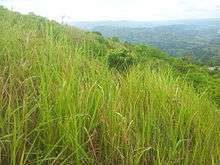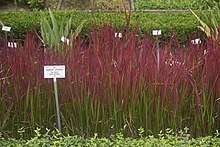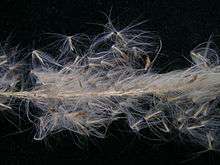Imperata cylindrica
Imperata cylindrica (commonly known as cogongrass /koʊˈɡoʊn/ or kunai grass /ˈkuːnaɪ/)[1][2]) is a species of perennial rhizomatous grass native to tropical and subtropical Asia, Micronesia, Melanesia, Australia, Africa, and southern Europe. It has also been introduced to Latin America, the Caribbean, and the southeastern United States. It is a highly flammable fire-adapted species, and can spread rapidly by colonizing disturbed areas and encouraging more frequent wildfires.[3]
| Imperata cylindrica | |
|---|---|
 | |
| Imperata cylindrica in Susami, Wakayama, Japan with mature seed heads | |
| Scientific classification | |
| Kingdom: | Plantae |
| Clade: | Tracheophytes |
| Clade: | Angiosperms |
| Clade: | Monocots |
| Clade: | Commelinids |
| Order: | Poales |
| Family: | Poaceae |
| Subfamily: | Panicoideae |
| Genus: | Imperata |
| Species: | I. cylindrica |
| Binomial name | |
| Imperata cylindrica | |
| Synonyms | |
|
See text | |
Common names

The species is most commonly known in English as "cogongrass",[2] from Spanish cogón, from the Tagalog and Visayan kugon.[4] Other common names in English include kunai grass, blady grass, satintail, spear grass, sword grass, thatch grass, alang-alang, lalang grass, cotton wool grass, and kura-kura among other names.[2]
Description
It grows from 0.6 to 3 m (2 to 10 feet) tall. The leaves are about 2 cm wide near the base of the plant and narrow to a sharp point at the top; the margins are finely toothed and are embedded with sharp silica crystals. The main vein is a lighter colour than the rest of the leaf and tends to be nearer to one side of the leaf. The upper surface is hairy near the base of the plant while the underside is usually hairless.[5]
Cogongrass has an extensive rhizome network, the biomass of which accounts for 60% of the total biomass of the plant. They can penetrate are up to 1.2 m (3.9 ft) deep, but 0.4 m (1.3 ft) is typical in sandy soil.[5][6]
Flammability
Cogongrass is a fire-adapted species. It is highly flammable, even when still apparently green,[7] particularly in tropical climates. It is not uncommon to see hillsides of cogongrass on fire.[8][9] Cogongrass depends on regular fires to spread and maintain ecological dominance. Because of its density and high biomass, cogongrass provides a very high fuel load, enabling wildfires to burn faster, higher, and much hotter. This is hot enough to kill most competing plants, including trees. After a fire, cogongrass will recolonize the area using their rhizome network which was unaffected by the fire.[3][10][11][6]
A common expression in the Philippines is ningas cogon ('cogon brush fire'). It is a figure of speech for procrastination, specifically people who show a fervent interest in a new project but lose interest quickly, in reference to the propensity of cogongrass to catch fire and burn out quickly.[12]
Phytochemistry
The plant contains the triterpenoids arundoin, cylindrin and fernenol.[13]
Cultivation and uses

It is used for thatching the roofs of traditional homes throughout south-east Asia.

It is planted extensively for ground cover and soil stabilization near beach areas and other areas subject to erosion. Other uses include paper-making, thatching and weaving into mats and bags. It is used in traditional Chinese medicine.[14]
A number of cultivars have been selected for garden use as ornamental plants, including the red-leaved 'Red Baron', also known as Japanese blood grass.
Young inflorescences and shoots may be eaten cooked, and the roots contain starch and sugars and are therefore easy to chew.[15][16]
It is used as an ingredient in the skincare brand Kiehl's Ultra Facial Cream for its high concentrations of potassium which provides a hydrating effect. Their website also states that indigenous native Australians may have used the plant as a substitute for salt due to its high saline content.[17]
Weed problems
The plant has become naturalized in the Americas, Northern Asia, Europe and Africa in addition to many islands and is listed as an invasive weed in some areas. In the U.S. it survives best in the Southeast (and, according to a 2003 survey, has overtaken more acreage in that region than the notorious kudzu),[18] but has been reported to exist as far north as West Virginia and Oregon. Worldwide it has been observed from 45°N to 45°S. It grows on wet lands, dry lands, areas of high salinity, organic soils, clay soils and sandy soils of pH from 4.0 to 7.5. It prefers full sun but will tolerate some shade. In Florida I. cylindrica is found in areas where the soil has been disturbed, such as roadsides, building sites, timber harvesting areas, and borrow pits. It is able to invade both moist and dry upland pine forests. Once established it often forms dense monocultures.[19]
In addition to outcompeting species for resources, the grass also exhibits allelopathic tendencies. The chemicals it releases as well as the dense mat of vegetation that usually accompanies a cogongrass invasion gives it an advantage over indigenous plants.[20]
It spreads both through small seeds, which are easily carried by the wind, and rhizomes which can be transported by tilling equipment and in soil transport.
In the Southeastern United States, state governments have various eradication efforts in place, and deliberate propagation is prohibited by some authorities.[21] Control is typically by the use of herbicides. Currently, the most effective herbicides used to control growth are glyphosate and imazapyr.[22] Burnoff is seldom successful since the grass burns at a high temperature causing heat damage to trees which would ordinarily be undamaged by a controlled burn and recovers from a burn quickly. Quarantine and extermination of this plant is especially difficult because cogongrass establishes root systems as deep as four feet, and regrowth can be triggered by rhizome segments as small as one inch.[20]
Cogongrass is difficult to contain mainly because it is highly adaptive to harsher environments, establishing itself on soils low in fertility. The grass also can grow on sand and clay, and consumers of it are few. The grass tends to be averse to dense shade, but reports indicate more shade-tolerant strains are developing.[23]
The legume vine Mucuna pruriens is used in the countries of Benin and Vietnam as a biological control for Imperata cylindrica.[24]
Taxonomy
Imperata cylindrica was first described by Linnaeus in 1759 under the basionym Lagurus cylindricus.[25] They were renamed by the French entomologist and botanist Palisot de Beauvois to the current accepted name of Imperata cylindrica.
Synonyms include:[26]
|
References
- "Imperata cylindrica". Germplasm Resources Information Network (GRIN). Agricultural Research Service (ARS), United States Department of Agriculture (USDA). Retrieved 2016-04-03.
- "Imperata cylindrica (cogongrass)". Centre for Agriculture and Bioscience International (CABI). Retrieved November 16, 2016.
- Pillion, Dennis. "This 'vicious' invasive plant burns hot enough to kill trees and stabs them with its roots". Alabama Local. Retrieved 3 July 2019.
- "Merriam-Webster Dictionary: Cogon". Merriam-webster.com. 2018-07-19. Retrieved 2018-07-26.
- "Imperata cylindrica". www.sms.si.edu. Retrieved 2016-03-31.
- Sellers, B. A.; Ferrell, J. A.; MacDonald, G. E.; Enloe, S. F.; Flory, S. L. (2002). "Cogongrass (Imperata cylindrica) Biology, Ecology, and Management in Florida Grazing Lands". Publication #SS-AGR-52. Agronomy Department, UF/IFAS Extensio.
- "Species Description: Imperata cylindrica (L.) Beauv". Archived from the original on 2010-07-28. Retrieved 2010-12-16.
- "'Establishment of Stylo (Stylosanthes Guianensis) in Kunai (Imperata cylindrica) pastures and its Effect of Dry Matter Yield and Animal Production in the Markham Valley, Papua New Guinea by P.A. Chadhokar" (PDF). Retrieved 2018-07-26.
- "Fire leaves 20 without shelter". Postcourier.com.pg. Archived from the original on 2012-03-08. Retrieved 2018-07-26.
- Stocker, Randall; Hupp, Karen V.S. (2008). "Fire and Nonnative Invasive Plants in the Southeast Bioregion". Wildland Fire in Ecosystems: Fire and nonnative invasive plants. Rocky Mountain Research Station, Forest Service, USDA. p. 103. ISBN 9780160814655.
- Lippincott, C.L. (2000). "Effects of Imperata cylindrica (L.) Beauv. (Cogongrass) invasion on fire regime in Florida sandhill (USA)". Natural Areas Journal. 20 (2): 140–149.
- "Filipino Culture: What is Ningas Cogon". Archived from the original on 2011-01-15. Retrieved 2010-12-16.
- The structures of arundoin, cylindrin and fernenol : Triterpenoids of fernane and arborane groups of imperata cylindrica var. koenigii. K. Nishimoto, M. Ito and S. Natori, Tetrahedron, 1968, Volume 24, Issue 2, Pages 735–752, doi:10.1016/0040-4020(68)88023-8
- "Imperata". Acupuncturetoday - traditional Chinese medicine (tcm). Retrieved 22 Dec 2014.
- "Imperata cylindrica". PFAF. Retrieved 2016-03-31.
- "Imperata cylindrica". Archived from the original on 2007-09-15. Retrieved 2007-08-12.
- "Ultra Facial Cream 24-Hour Moisturizer - Kiehl's". Kiehls.com. Retrieved 2018-07-26.
- Aggressive weed becoming a menace worse than kudzu Archived 2008-05-17 at the Wayback Machine, UF researcher says]
- "Cogongrass". Invasive Non-native Plants. Florida Department of Agriculture and Consumer Services. Retrieved 2013-11-25.
- Long, Elizabeth A. "Identification and Control Methods for Cogongrass in Tennessee" (PDF). Tennessee invasives. University of Tennessee. Retrieved March 30, 2016.
- Dozier, Hallie; Gaffney, James F.; McDonald, Sandra K.; Johnson, Eric R. R. L.; Shilling, Donn G. (1998-01-01). "Cogongrass in the United States: History, Ecology, Impacts, and Management". Weed Technology. 12 (4): 737–743. JSTOR 3989097.
- "Imperata cylindrica | UF/IFAS Center for Aquatic and Invasive Plants". plants.ifas.ufl.edu. Retrieved 2016-03-31.
- "Factsheet - Mucuna pruriens". www.tropicalforages.info. Archived from the original on 2008-05-15. Retrieved 2008-05-21.
- Wunderlin, R. P., and B. F. Hansen. 2008. Imperata cylindrica. Atlas of Florida Vascular Plants <http://www.plantatlas.usf.edu/>.[S. M. Landry and K. N. Campbell (application development), Florida Center for Community Design and Research.] Institute for Systematic Botany, University of South Florida, Tampa.
- "Imperata cylindrica". World Checklist of Selected Plant Families (WCSP). Royal Botanic Gardens, Kew. Retrieved 18 June 2017.
External links
| Wikimedia Commons has media related to Imperata cylindrica. |
- Characteristics and management of Imperata cylindrica (L.) Raeuschel in smallholder farms in developing countries, Food and Agriculture Organization of the United Nations
- PFAF.org: Cultivation and edible/medicinal uses of Imperata cylindrica
- Imperata cylindrica, Grass Genera of the World
- USDA Plants Profile for Imperata cylindrica (cogongrass) — invasive species.
- Least Wanted: Cogon Grass, Plant Conservation Alliance's Alien Plant Working Group
- WageningenUR.nl: "From Imperata cylindrica Grasslands to productive Agroforestry" — Murniati PhD thesis (2002).
- United States National Agricultural Library, National Invasive Species Information Center: Species profile for Imperata cylindrica (Cogongrass) — information and control resources.